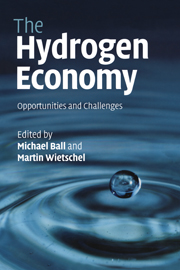Book contents
- Frontmatter
- Contents
- List of main contributors
- Preface
- Acknowledgements
- List of abbreviations
- 1 Scope of the book
- 2 Why hydrogen?
- 3 Non-renewable energy resources: fossil fuels – supply and future availability
- 4 Non-renewable energy resources: nuclear fuels
- 5 Assessment of the potentials for renewable energy sources
- 6 Carbon capture and storage
- 7 Energy-chain analysis of hydrogen and its competing alternative fuels for transport
- 8 Hydrogen today
- 9 Fundamental properties of hydrogen
- 10 Hydrogen production
- 11 Hydrogen storage
- 12 Hydrogen distribution
- 13 Key role of fuel cells
- 14 Hydrogen-infrastructure build-up in Europe
- 15 Building a hydrogen infrastructure in the USA
- 16 Hydrogen and the electricity sector
- 17 Hydrogen corridors
- 18 Macroeconomic impacts of hydrogen
- 19 Sustainable transport visions: the role of hydrogen and fuel-cell vehicle technologies
- 20 Energy-efficient solutions needed – paving the way for hydrogen
- 21 The future of hydrogen – opportunities and challenges
- Further reading
- Index
- References
13 - Key role of fuel cells
Published online by Cambridge University Press: 22 January 2010
- Frontmatter
- Contents
- List of main contributors
- Preface
- Acknowledgements
- List of abbreviations
- 1 Scope of the book
- 2 Why hydrogen?
- 3 Non-renewable energy resources: fossil fuels – supply and future availability
- 4 Non-renewable energy resources: nuclear fuels
- 5 Assessment of the potentials for renewable energy sources
- 6 Carbon capture and storage
- 7 Energy-chain analysis of hydrogen and its competing alternative fuels for transport
- 8 Hydrogen today
- 9 Fundamental properties of hydrogen
- 10 Hydrogen production
- 11 Hydrogen storage
- 12 Hydrogen distribution
- 13 Key role of fuel cells
- 14 Hydrogen-infrastructure build-up in Europe
- 15 Building a hydrogen infrastructure in the USA
- 16 Hydrogen and the electricity sector
- 17 Hydrogen corridors
- 18 Macroeconomic impacts of hydrogen
- 19 Sustainable transport visions: the role of hydrogen and fuel-cell vehicle technologies
- 20 Energy-efficient solutions needed – paving the way for hydrogen
- 21 The future of hydrogen – opportunities and challenges
- Further reading
- Index
- References
Summary
Some of the most important benefits of hydrogen can only be realised if hydrogen is used in fuel cells; for instance, the high overall conversion efficiency compared with the internal combustion engine, as well as the reduction of local pollution and noise. Therefore, the market success of fuel cells plays a key role in a hydrogen economy. The following chapter gives a brief introduction to the fuel cell as a technology and describes the various types of fuel cells and their potential uses in mobile, stationary and portable applications. However, preparing for the structural changes in industry is just as important as the technical optimisation of fuel cells, and the remainder of the chapter is devoted to this aspect.
Historical development of fuel cells
Fuel-cell technology first took off more than 170 years ago. In 1839, the Welsh judge, Sir William Grove, presented the first fuel-cell battery, in which he was able to generate an electrical current from hydrogen and oxygen by reversing the process of electrolysis (Grove,1839). The electrodes were platinum and sulphuric acid was used as the electrolyte. Since the invention of the fuel cell, expectations of their broad market introduction have built up into waves several times, but have then crashed each time. One such wave is demonstrated by the speech of Wilhelm Ostwald, the famous electrochemist, to the Bunsengesellschaft in 1894, in which he stated that fuel cells are superior to steam engines and all other kinds of incineration technique (Ostwald, 1894).
- Type
- Chapter
- Information
- The Hydrogen EconomyOpportunities and Challenges, pp. 348 - 384Publisher: Cambridge University PressPrint publication year: 2009
References
- 2
- Cited by



